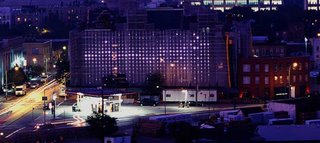By Richard Brown and Jon Oberlander
21/2/06
* The Six Sub-Projects
1. InSpace: InsideOut and OutsideIn
Heavily AV dependent; wall projection displays, internal displays, cameras (includes biospace)
InSpace is the public-facing gallery space on the south east corner of the building. It has big east-facing windows, that can be used as a display screen, showing people outside visualisations of what's happening inside - and letting them interact with intriguing, every-changing visuals. For the vision for the space, see:
http://homepages.inf.ed.ac.uk/jon/inspace/is.pdf
Schematic of possible interactive installation (.doc)
2. Discrete interactive installations
A set of dataprojector/camera combos: Simple AV, up to 2-3 per floor of main building, where light levels permit
The idea is to have, at various corridor points in the main building, a simple dataprojector/camera/wall combination, for smaller-scale versions of the big InSpace interactive display. Each could house an initial artistic commission, though it would be good to have a rolling programme, so that people don't get bored with what they see.
3. Robotic atrium
Moving panels, tracking dataprojectors
The forum atrium is the main space in the building. The idea is to animate that space by having a set of up to 24 moving panels on the inner walls. The panels have images projected onto them from a set of steerable dataprojectors. They respond to each other and to people in the space, sliding from place to place. If needed, they can be commanded to swarm together, forming a single large projection screen.
video simulation mock up (2Mb .mpg)
4. Moving words: RFID/screen system
Cards/badges with RFID, picked up in atrium, tracked at 1 site per floor, one RFID detector and video display per floor.
The idea is that visitors (and residents) pick up a card as they enter; the cards are either pre-printed with words, or the individual can programme a word onto it when they pick it up. The card also contains an RFID chip. At one point per floor (by the stairwell), there is an RFID reader, which picks up all the cards in its
vicinity. Background natural language processing takes all the words, displays them, and then either produces sentences/poetry containing those words, or else finds linking words, that bridge between the words brought by the visitors.
5. Smart cafe tables: cafeteria
Dataprojector and camera set beneath each table in cafeteria, up-projecting onto table surface. Requires bepoke tables, power, network connections.
Each table in cafe area becomes both a virtual window into an aquarium filled with strange creatures; and it becomes an interactive networked display, to let people google or scribble to their heart's content.

see Soft Sensing for possible technical solutions
6. Building as machine: Window dressing
Use each window in building with modular (speck-like) technology to sense external conditions (eg wind, noise) and respond by altering LED illuminating light, cellular automata style.
The windows of the building at night would show rippling, every-changing patterns.
Something like this?
[Model of a proposal by James Clar for a habitat hotel ]
Supercluster: Wall of LED's inspired by particle dynamics and Cellular Automata by Leo Villareal

As used recently by the re-launched Human League, an LED curtain by Chroma-Q - Color Web transparent & modular LED matrix (nov 05)

The Networked Building (5/4/06 RB )
It is envisaged that all of the proposed interactive systems will be networked, creating a digital nervous system running through the building, enabling all types of information to be sensed, processed and output from any point to any other - data that follows you, from the tables to the robotic atrium, the rooftop to a floor based installation, the subliminal sounds and images of data flow..
To create an infrastructure that supports intelligent communications AND provocative artistic interventions. The Perth Concert Hall is the nearest local example of this type of "Intelligent and Purposeful Building", built on a specially created platform called Threshold - a system we hope to be able to use and co-develop...
Or possibly Arch-OS..being developed at Portsmouth. see Building Operating Systems for more...



